Strategic Project Management Planning
VerifiedAdded on 2022/12/18
|11
|1698
|57
AI Summary
This document discusses the importance of projects in supporting the strategic objectives of an organization. It also evaluates the internal and external factors that influence project selection. Additionally, it examines the roles of project stakeholders in planning and ways to establish project viability against specified criteria. Lastly, it explores the components and characteristics of a project plan and provides guidance on how to prepare one.
Contribute Materials
Your contribution can guide someone’s learning journey. Share your
documents today.
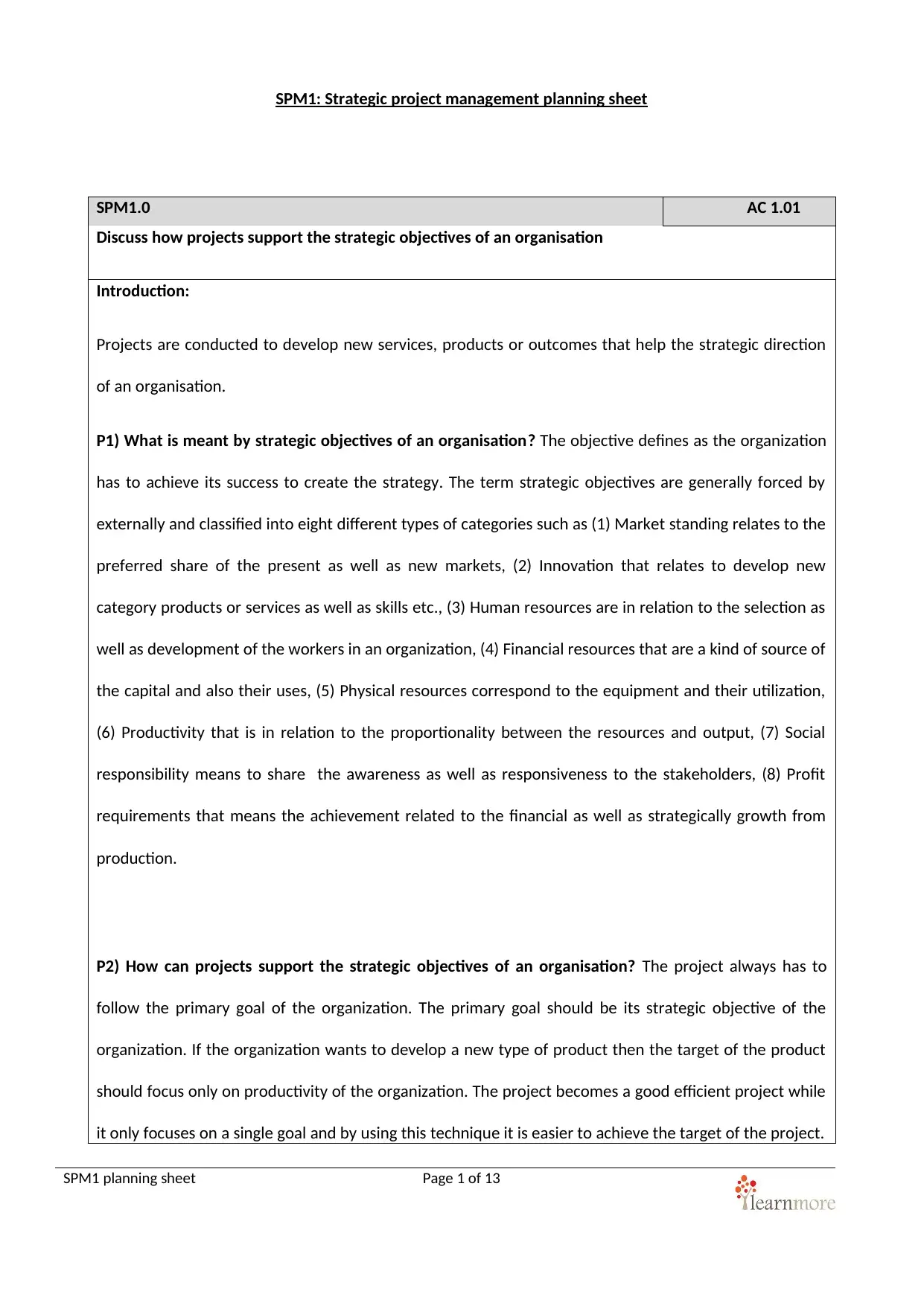
SPM1: Strategic project management planning sheet
SPM1.0 AC 1.01
Discuss how projects support the strategic objectives of an organisation
Introduction:
Projects are conducted to develop new services, products or outcomes that help the strategic direction
of an organisation.
P1) What is meant by strategic objectives of an organisation? The objective defines as the organization
has to achieve its success to create the strategy. The term strategic objectives are generally forced by
externally and classified into eight different types of categories such as (1) Market standing relates to the
preferred share of the present as well as new markets, (2) Innovation that relates to develop new
category products or services as well as skills etc., (3) Human resources are in relation to the selection as
well as development of the workers in an organization, (4) Financial resources that are a kind of source of
the capital and also their uses, (5) Physical resources correspond to the equipment and their utilization,
(6) Productivity that is in relation to the proportionality between the resources and output, (7) Social
responsibility means to share the awareness as well as responsiveness to the stakeholders, (8) Profit
requirements that means the achievement related to the financial as well as strategically growth from
production.
P2) How can projects support the strategic objectives of an organisation? The project always has to
follow the primary goal of the organization. The primary goal should be its strategic objective of the
organization. If the organization wants to develop a new type of product then the target of the product
should focus only on productivity of the organization. The project becomes a good efficient project while
it only focuses on a single goal and by using this technique it is easier to achieve the target of the project.
SPM1 planning sheet Page 1 of 13
SPM1.0 AC 1.01
Discuss how projects support the strategic objectives of an organisation
Introduction:
Projects are conducted to develop new services, products or outcomes that help the strategic direction
of an organisation.
P1) What is meant by strategic objectives of an organisation? The objective defines as the organization
has to achieve its success to create the strategy. The term strategic objectives are generally forced by
externally and classified into eight different types of categories such as (1) Market standing relates to the
preferred share of the present as well as new markets, (2) Innovation that relates to develop new
category products or services as well as skills etc., (3) Human resources are in relation to the selection as
well as development of the workers in an organization, (4) Financial resources that are a kind of source of
the capital and also their uses, (5) Physical resources correspond to the equipment and their utilization,
(6) Productivity that is in relation to the proportionality between the resources and output, (7) Social
responsibility means to share the awareness as well as responsiveness to the stakeholders, (8) Profit
requirements that means the achievement related to the financial as well as strategically growth from
production.
P2) How can projects support the strategic objectives of an organisation? The project always has to
follow the primary goal of the organization. The primary goal should be its strategic objective of the
organization. If the organization wants to develop a new type of product then the target of the product
should focus only on productivity of the organization. The project becomes a good efficient project while
it only focuses on a single goal and by using this technique it is easier to achieve the target of the project.
SPM1 planning sheet Page 1 of 13
Secure Best Marks with AI Grader
Need help grading? Try our AI Grader for instant feedback on your assignments.
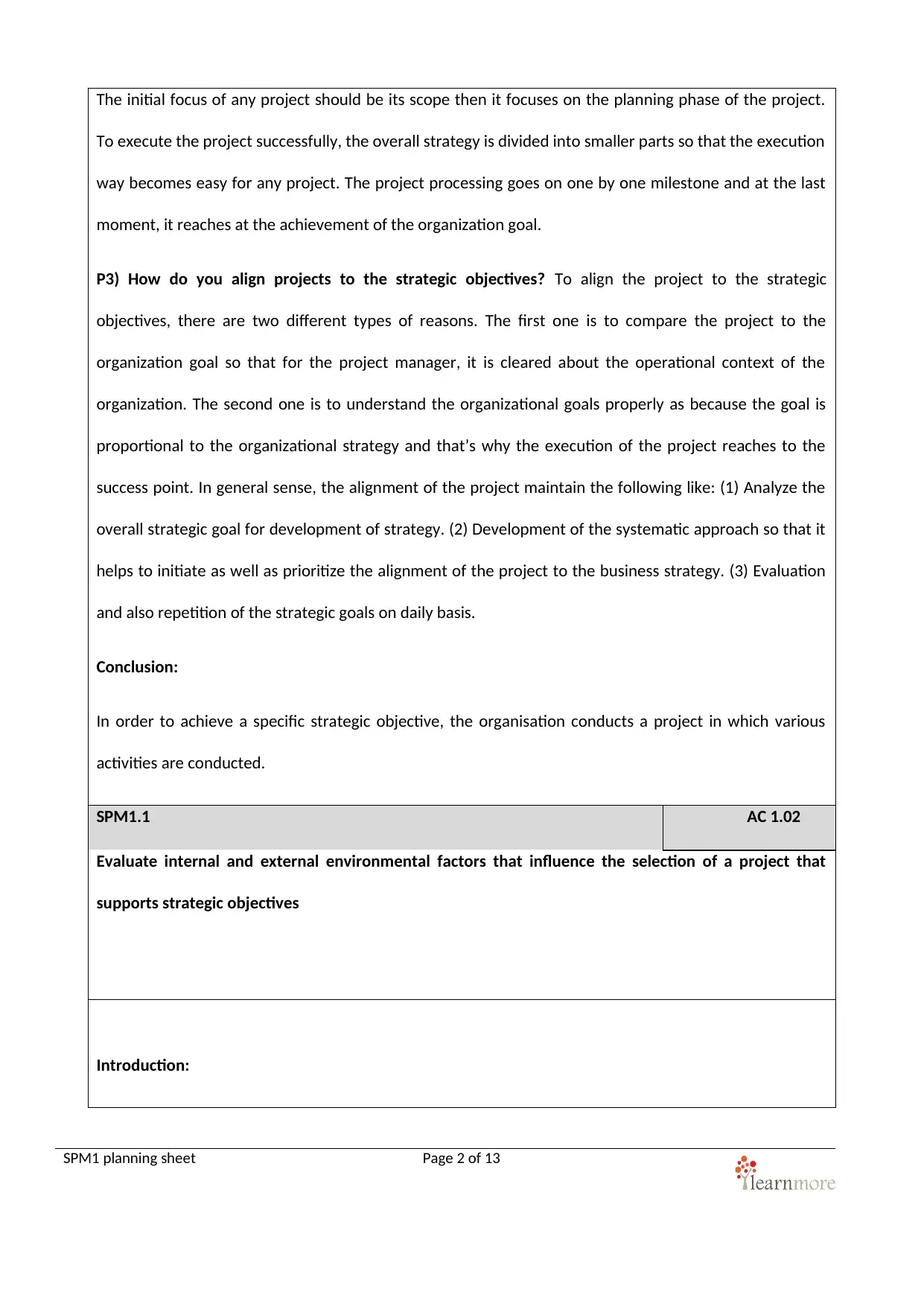
The initial focus of any project should be its scope then it focuses on the planning phase of the project.
To execute the project successfully, the overall strategy is divided into smaller parts so that the execution
way becomes easy for any project. The project processing goes on one by one milestone and at the last
moment, it reaches at the achievement of the organization goal.
P3) How do you align projects to the strategic objectives? To align the project to the strategic
objectives, there are two different types of reasons. The first one is to compare the project to the
organization goal so that for the project manager, it is cleared about the operational context of the
organization. The second one is to understand the organizational goals properly as because the goal is
proportional to the organizational strategy and that’s why the execution of the project reaches to the
success point. In general sense, the alignment of the project maintain the following like: (1) Analyze the
overall strategic goal for development of strategy. (2) Development of the systematic approach so that it
helps to initiate as well as prioritize the alignment of the project to the business strategy. (3) Evaluation
and also repetition of the strategic goals on daily basis.
Conclusion:
In order to achieve a specific strategic objective, the organisation conducts a project in which various
activities are conducted.
SPM1.1 AC 1.02
Evaluate internal and external environmental factors that influence the selection of a project that
supports strategic objectives
Introduction:
SPM1 planning sheet Page 2 of 13
To execute the project successfully, the overall strategy is divided into smaller parts so that the execution
way becomes easy for any project. The project processing goes on one by one milestone and at the last
moment, it reaches at the achievement of the organization goal.
P3) How do you align projects to the strategic objectives? To align the project to the strategic
objectives, there are two different types of reasons. The first one is to compare the project to the
organization goal so that for the project manager, it is cleared about the operational context of the
organization. The second one is to understand the organizational goals properly as because the goal is
proportional to the organizational strategy and that’s why the execution of the project reaches to the
success point. In general sense, the alignment of the project maintain the following like: (1) Analyze the
overall strategic goal for development of strategy. (2) Development of the systematic approach so that it
helps to initiate as well as prioritize the alignment of the project to the business strategy. (3) Evaluation
and also repetition of the strategic goals on daily basis.
Conclusion:
In order to achieve a specific strategic objective, the organisation conducts a project in which various
activities are conducted.
SPM1.1 AC 1.02
Evaluate internal and external environmental factors that influence the selection of a project that
supports strategic objectives
Introduction:
SPM1 planning sheet Page 2 of 13
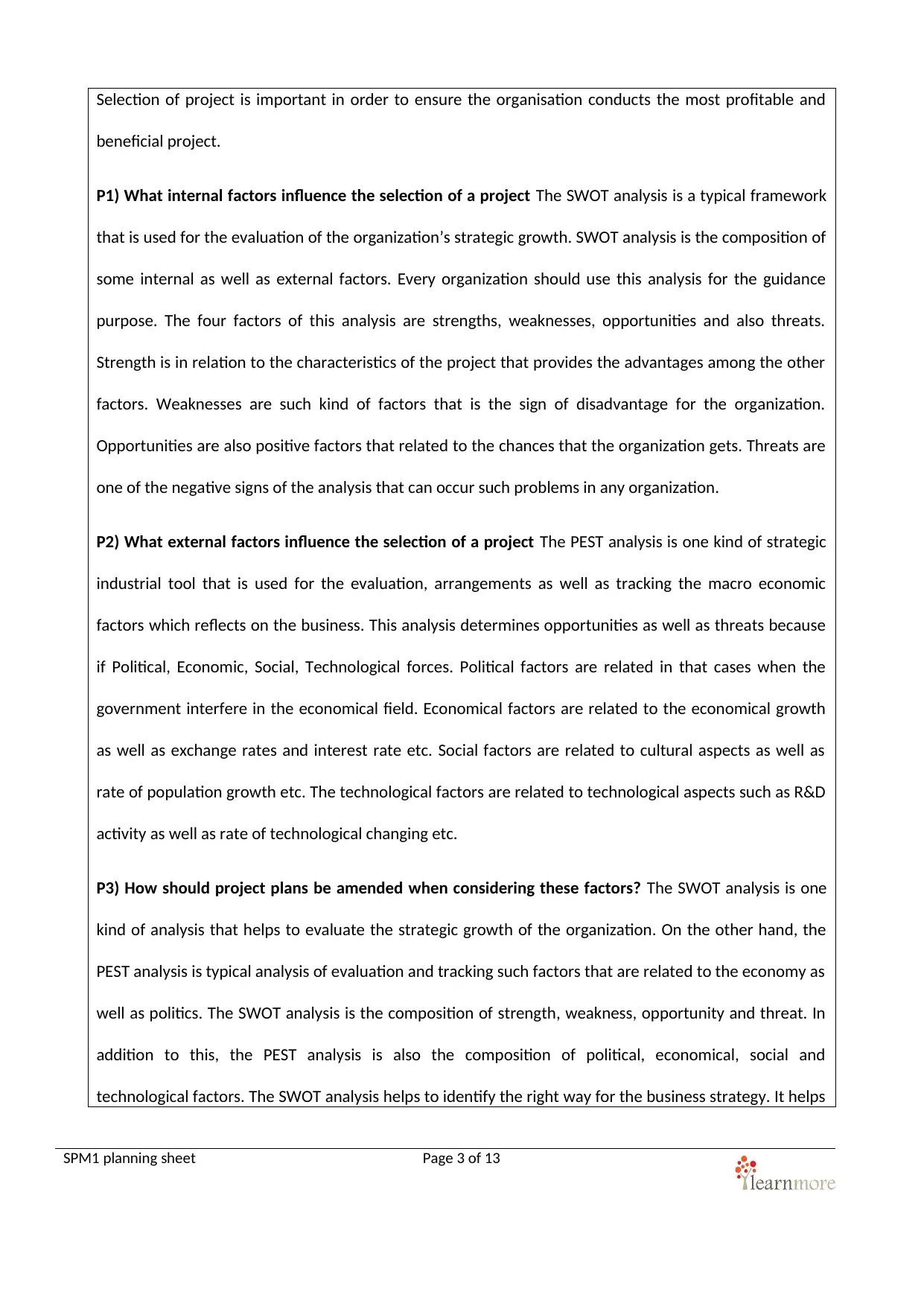
Selection of project is important in order to ensure the organisation conducts the most profitable and
beneficial project.
P1) What internal factors influence the selection of a project The SWOT analysis is a typical framework
that is used for the evaluation of the organization’s strategic growth. SWOT analysis is the composition of
some internal as well as external factors. Every organization should use this analysis for the guidance
purpose. The four factors of this analysis are strengths, weaknesses, opportunities and also threats.
Strength is in relation to the characteristics of the project that provides the advantages among the other
factors. Weaknesses are such kind of factors that is the sign of disadvantage for the organization.
Opportunities are also positive factors that related to the chances that the organization gets. Threats are
one of the negative signs of the analysis that can occur such problems in any organization.
P2) What external factors influence the selection of a project The PEST analysis is one kind of strategic
industrial tool that is used for the evaluation, arrangements as well as tracking the macro economic
factors which reflects on the business. This analysis determines opportunities as well as threats because
if Political, Economic, Social, Technological forces. Political factors are related in that cases when the
government interfere in the economical field. Economical factors are related to the economical growth
as well as exchange rates and interest rate etc. Social factors are related to cultural aspects as well as
rate of population growth etc. The technological factors are related to technological aspects such as R&D
activity as well as rate of technological changing etc.
P3) How should project plans be amended when considering these factors? The SWOT analysis is one
kind of analysis that helps to evaluate the strategic growth of the organization. On the other hand, the
PEST analysis is typical analysis of evaluation and tracking such factors that are related to the economy as
well as politics. The SWOT analysis is the composition of strength, weakness, opportunity and threat. In
addition to this, the PEST analysis is also the composition of political, economical, social and
technological factors. The SWOT analysis helps to identify the right way for the business strategy. It helps
SPM1 planning sheet Page 3 of 13
beneficial project.
P1) What internal factors influence the selection of a project The SWOT analysis is a typical framework
that is used for the evaluation of the organization’s strategic growth. SWOT analysis is the composition of
some internal as well as external factors. Every organization should use this analysis for the guidance
purpose. The four factors of this analysis are strengths, weaknesses, opportunities and also threats.
Strength is in relation to the characteristics of the project that provides the advantages among the other
factors. Weaknesses are such kind of factors that is the sign of disadvantage for the organization.
Opportunities are also positive factors that related to the chances that the organization gets. Threats are
one of the negative signs of the analysis that can occur such problems in any organization.
P2) What external factors influence the selection of a project The PEST analysis is one kind of strategic
industrial tool that is used for the evaluation, arrangements as well as tracking the macro economic
factors which reflects on the business. This analysis determines opportunities as well as threats because
if Political, Economic, Social, Technological forces. Political factors are related in that cases when the
government interfere in the economical field. Economical factors are related to the economical growth
as well as exchange rates and interest rate etc. Social factors are related to cultural aspects as well as
rate of population growth etc. The technological factors are related to technological aspects such as R&D
activity as well as rate of technological changing etc.
P3) How should project plans be amended when considering these factors? The SWOT analysis is one
kind of analysis that helps to evaluate the strategic growth of the organization. On the other hand, the
PEST analysis is typical analysis of evaluation and tracking such factors that are related to the economy as
well as politics. The SWOT analysis is the composition of strength, weakness, opportunity and threat. In
addition to this, the PEST analysis is also the composition of political, economical, social and
technological factors. The SWOT analysis helps to identify the right way for the business strategy. It helps
SPM1 planning sheet Page 3 of 13
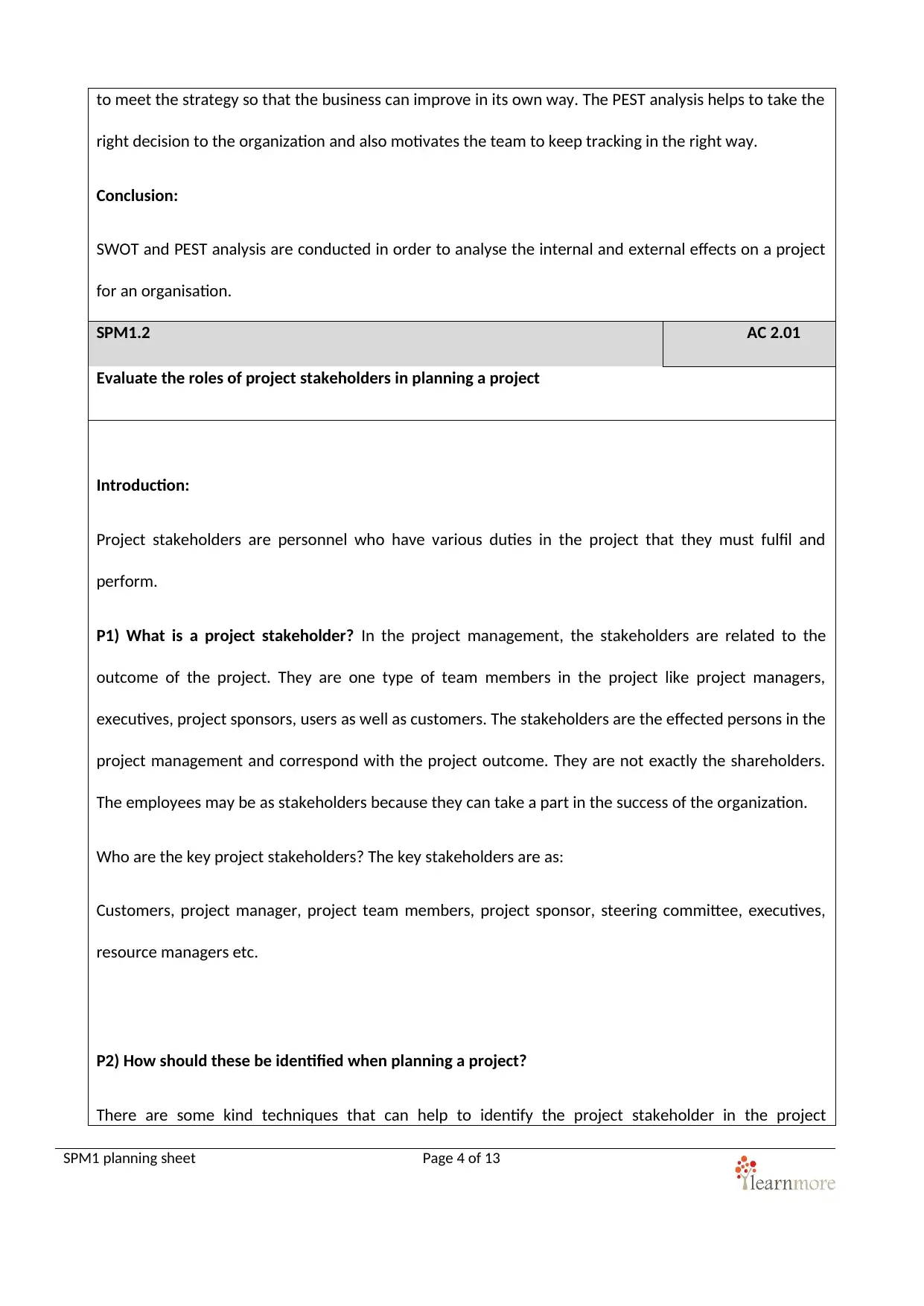
to meet the strategy so that the business can improve in its own way. The PEST analysis helps to take the
right decision to the organization and also motivates the team to keep tracking in the right way.
Conclusion:
SWOT and PEST analysis are conducted in order to analyse the internal and external effects on a project
for an organisation.
SPM1.2 AC 2.01
Evaluate the roles of project stakeholders in planning a project
Introduction:
Project stakeholders are personnel who have various duties in the project that they must fulfil and
perform.
P1) What is a project stakeholder? In the project management, the stakeholders are related to the
outcome of the project. They are one type of team members in the project like project managers,
executives, project sponsors, users as well as customers. The stakeholders are the effected persons in the
project management and correspond with the project outcome. They are not exactly the shareholders.
The employees may be as stakeholders because they can take a part in the success of the organization.
Who are the key project stakeholders? The key stakeholders are as:
Customers, project manager, project team members, project sponsor, steering committee, executives,
resource managers etc.
P2) How should these be identified when planning a project?
There are some kind techniques that can help to identify the project stakeholder in the project
SPM1 planning sheet Page 4 of 13
right decision to the organization and also motivates the team to keep tracking in the right way.
Conclusion:
SWOT and PEST analysis are conducted in order to analyse the internal and external effects on a project
for an organisation.
SPM1.2 AC 2.01
Evaluate the roles of project stakeholders in planning a project
Introduction:
Project stakeholders are personnel who have various duties in the project that they must fulfil and
perform.
P1) What is a project stakeholder? In the project management, the stakeholders are related to the
outcome of the project. They are one type of team members in the project like project managers,
executives, project sponsors, users as well as customers. The stakeholders are the effected persons in the
project management and correspond with the project outcome. They are not exactly the shareholders.
The employees may be as stakeholders because they can take a part in the success of the organization.
Who are the key project stakeholders? The key stakeholders are as:
Customers, project manager, project team members, project sponsor, steering committee, executives,
resource managers etc.
P2) How should these be identified when planning a project?
There are some kind techniques that can help to identify the project stakeholder in the project
SPM1 planning sheet Page 4 of 13
Secure Best Marks with AI Grader
Need help grading? Try our AI Grader for instant feedback on your assignments.
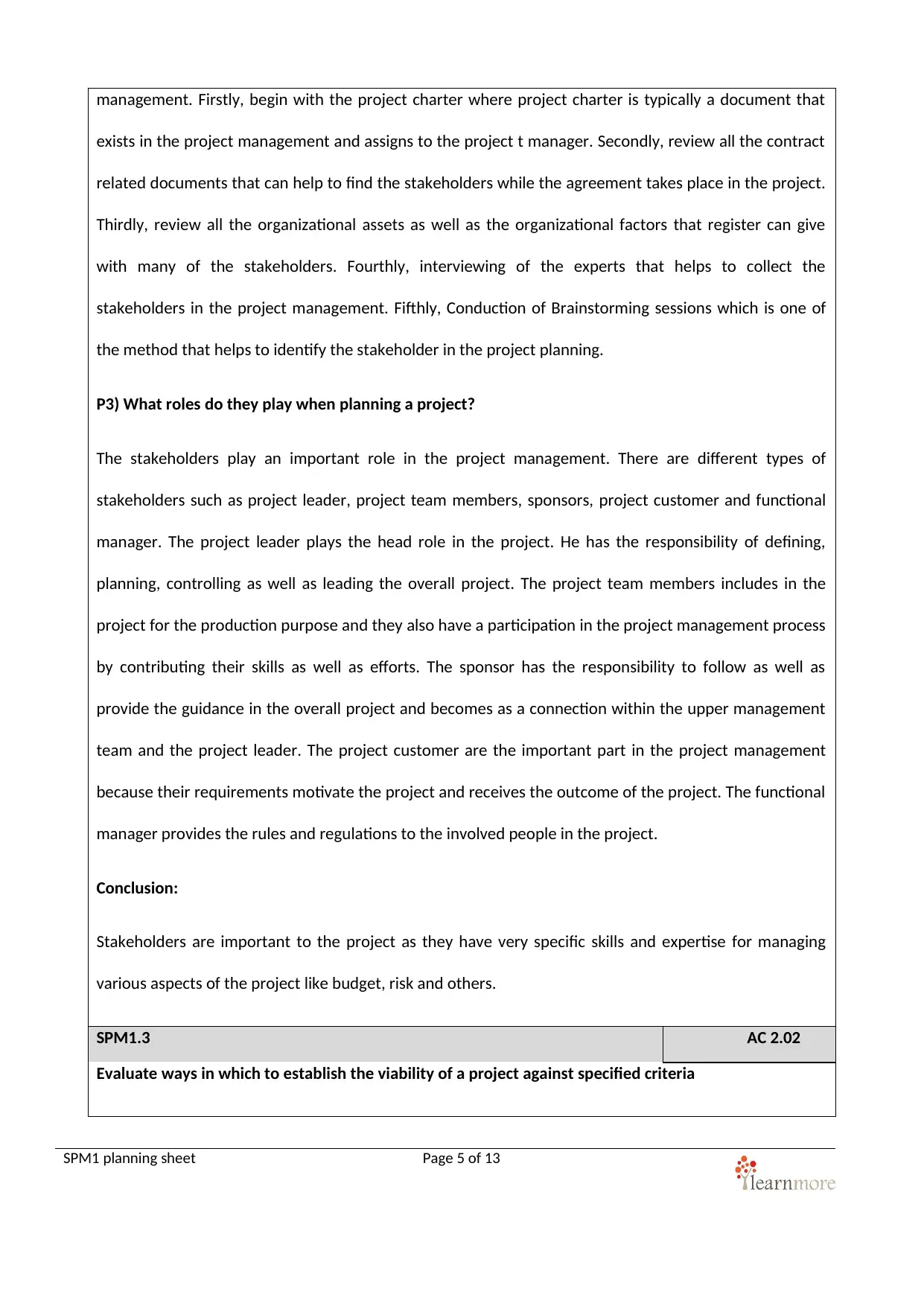
management. Firstly, begin with the project charter where project charter is typically a document that
exists in the project management and assigns to the project t manager. Secondly, review all the contract
related documents that can help to find the stakeholders while the agreement takes place in the project.
Thirdly, review all the organizational assets as well as the organizational factors that register can give
with many of the stakeholders. Fourthly, interviewing of the experts that helps to collect the
stakeholders in the project management. Fifthly, Conduction of Brainstorming sessions which is one of
the method that helps to identify the stakeholder in the project planning.
P3) What roles do they play when planning a project?
The stakeholders play an important role in the project management. There are different types of
stakeholders such as project leader, project team members, sponsors, project customer and functional
manager. The project leader plays the head role in the project. He has the responsibility of defining,
planning, controlling as well as leading the overall project. The project team members includes in the
project for the production purpose and they also have a participation in the project management process
by contributing their skills as well as efforts. The sponsor has the responsibility to follow as well as
provide the guidance in the overall project and becomes as a connection within the upper management
team and the project leader. The project customer are the important part in the project management
because their requirements motivate the project and receives the outcome of the project. The functional
manager provides the rules and regulations to the involved people in the project.
Conclusion:
Stakeholders are important to the project as they have very specific skills and expertise for managing
various aspects of the project like budget, risk and others.
SPM1.3 AC 2.02
Evaluate ways in which to establish the viability of a project against specified criteria
SPM1 planning sheet Page 5 of 13
exists in the project management and assigns to the project t manager. Secondly, review all the contract
related documents that can help to find the stakeholders while the agreement takes place in the project.
Thirdly, review all the organizational assets as well as the organizational factors that register can give
with many of the stakeholders. Fourthly, interviewing of the experts that helps to collect the
stakeholders in the project management. Fifthly, Conduction of Brainstorming sessions which is one of
the method that helps to identify the stakeholder in the project planning.
P3) What roles do they play when planning a project?
The stakeholders play an important role in the project management. There are different types of
stakeholders such as project leader, project team members, sponsors, project customer and functional
manager. The project leader plays the head role in the project. He has the responsibility of defining,
planning, controlling as well as leading the overall project. The project team members includes in the
project for the production purpose and they also have a participation in the project management process
by contributing their skills as well as efforts. The sponsor has the responsibility to follow as well as
provide the guidance in the overall project and becomes as a connection within the upper management
team and the project leader. The project customer are the important part in the project management
because their requirements motivate the project and receives the outcome of the project. The functional
manager provides the rules and regulations to the involved people in the project.
Conclusion:
Stakeholders are important to the project as they have very specific skills and expertise for managing
various aspects of the project like budget, risk and others.
SPM1.3 AC 2.02
Evaluate ways in which to establish the viability of a project against specified criteria
SPM1 planning sheet Page 5 of 13
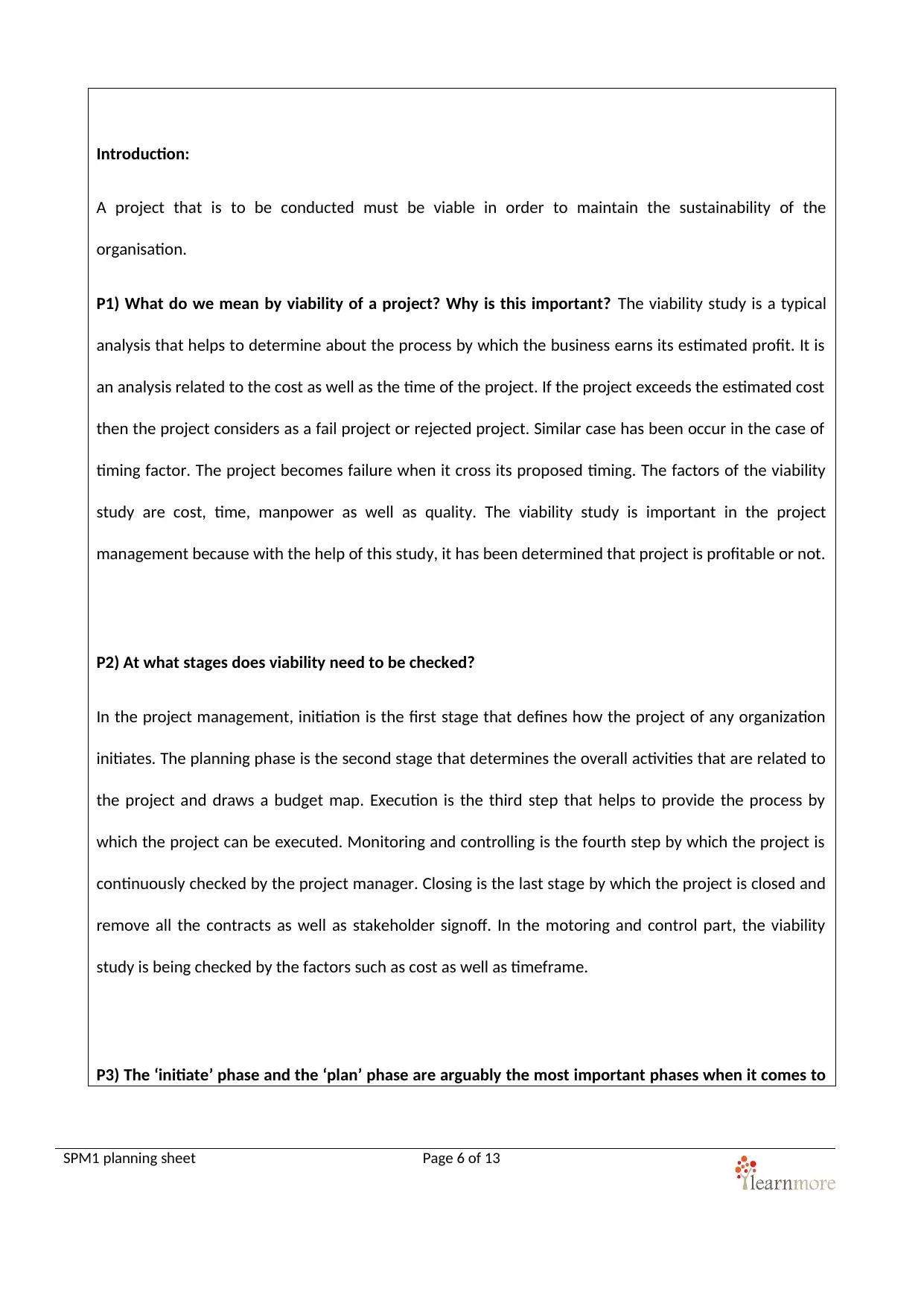
Introduction:
A project that is to be conducted must be viable in order to maintain the sustainability of the
organisation.
P1) What do we mean by viability of a project? Why is this important? The viability study is a typical
analysis that helps to determine about the process by which the business earns its estimated profit. It is
an analysis related to the cost as well as the time of the project. If the project exceeds the estimated cost
then the project considers as a fail project or rejected project. Similar case has been occur in the case of
timing factor. The project becomes failure when it cross its proposed timing. The factors of the viability
study are cost, time, manpower as well as quality. The viability study is important in the project
management because with the help of this study, it has been determined that project is profitable or not.
P2) At what stages does viability need to be checked?
In the project management, initiation is the first stage that defines how the project of any organization
initiates. The planning phase is the second stage that determines the overall activities that are related to
the project and draws a budget map. Execution is the third step that helps to provide the process by
which the project can be executed. Monitoring and controlling is the fourth step by which the project is
continuously checked by the project manager. Closing is the last stage by which the project is closed and
remove all the contracts as well as stakeholder signoff. In the motoring and control part, the viability
study is being checked by the factors such as cost as well as timeframe.
P3) The ‘initiate’ phase and the ‘plan’ phase are arguably the most important phases when it comes to
SPM1 planning sheet Page 6 of 13
A project that is to be conducted must be viable in order to maintain the sustainability of the
organisation.
P1) What do we mean by viability of a project? Why is this important? The viability study is a typical
analysis that helps to determine about the process by which the business earns its estimated profit. It is
an analysis related to the cost as well as the time of the project. If the project exceeds the estimated cost
then the project considers as a fail project or rejected project. Similar case has been occur in the case of
timing factor. The project becomes failure when it cross its proposed timing. The factors of the viability
study are cost, time, manpower as well as quality. The viability study is important in the project
management because with the help of this study, it has been determined that project is profitable or not.
P2) At what stages does viability need to be checked?
In the project management, initiation is the first stage that defines how the project of any organization
initiates. The planning phase is the second stage that determines the overall activities that are related to
the project and draws a budget map. Execution is the third step that helps to provide the process by
which the project can be executed. Monitoring and controlling is the fourth step by which the project is
continuously checked by the project manager. Closing is the last stage by which the project is closed and
remove all the contracts as well as stakeholder signoff. In the motoring and control part, the viability
study is being checked by the factors such as cost as well as timeframe.
P3) The ‘initiate’ phase and the ‘plan’ phase are arguably the most important phases when it comes to
SPM1 planning sheet Page 6 of 13
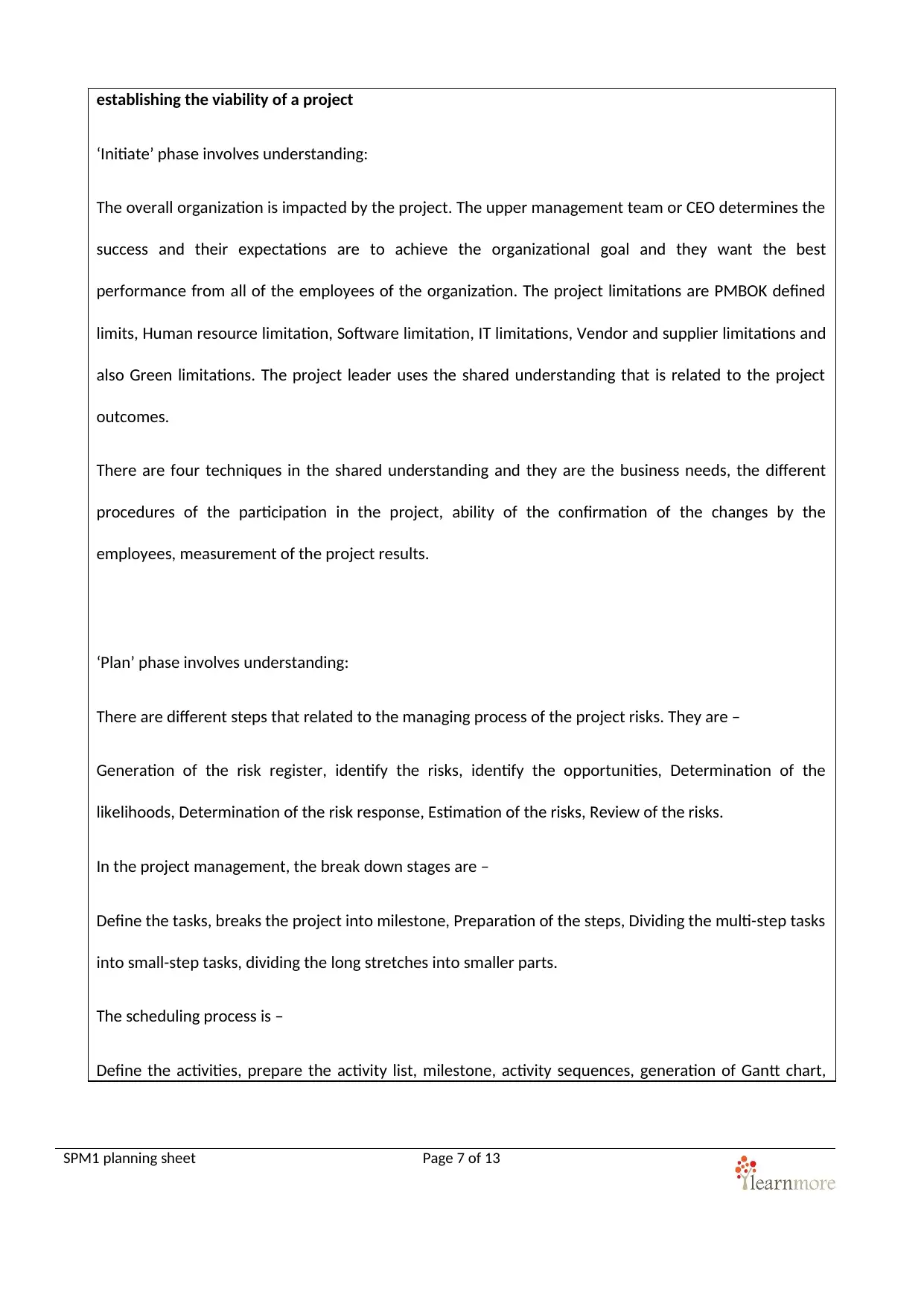
establishing the viability of a project
‘Initiate’ phase involves understanding:
The overall organization is impacted by the project. The upper management team or CEO determines the
success and their expectations are to achieve the organizational goal and they want the best
performance from all of the employees of the organization. The project limitations are PMBOK defined
limits, Human resource limitation, Software limitation, IT limitations, Vendor and supplier limitations and
also Green limitations. The project leader uses the shared understanding that is related to the project
outcomes.
There are four techniques in the shared understanding and they are the business needs, the different
procedures of the participation in the project, ability of the confirmation of the changes by the
employees, measurement of the project results.
‘Plan’ phase involves understanding:
There are different steps that related to the managing process of the project risks. They are –
Generation of the risk register, identify the risks, identify the opportunities, Determination of the
likelihoods, Determination of the risk response, Estimation of the risks, Review of the risks.
In the project management, the break down stages are –
Define the tasks, breaks the project into milestone, Preparation of the steps, Dividing the multi-step tasks
into small-step tasks, dividing the long stretches into smaller parts.
The scheduling process is –
Define the activities, prepare the activity list, milestone, activity sequences, generation of Gantt chart,
SPM1 planning sheet Page 7 of 13
‘Initiate’ phase involves understanding:
The overall organization is impacted by the project. The upper management team or CEO determines the
success and their expectations are to achieve the organizational goal and they want the best
performance from all of the employees of the organization. The project limitations are PMBOK defined
limits, Human resource limitation, Software limitation, IT limitations, Vendor and supplier limitations and
also Green limitations. The project leader uses the shared understanding that is related to the project
outcomes.
There are four techniques in the shared understanding and they are the business needs, the different
procedures of the participation in the project, ability of the confirmation of the changes by the
employees, measurement of the project results.
‘Plan’ phase involves understanding:
There are different steps that related to the managing process of the project risks. They are –
Generation of the risk register, identify the risks, identify the opportunities, Determination of the
likelihoods, Determination of the risk response, Estimation of the risks, Review of the risks.
In the project management, the break down stages are –
Define the tasks, breaks the project into milestone, Preparation of the steps, Dividing the multi-step tasks
into small-step tasks, dividing the long stretches into smaller parts.
The scheduling process is –
Define the activities, prepare the activity list, milestone, activity sequences, generation of Gantt chart,
SPM1 planning sheet Page 7 of 13
Paraphrase This Document
Need a fresh take? Get an instant paraphrase of this document with our AI Paraphraser
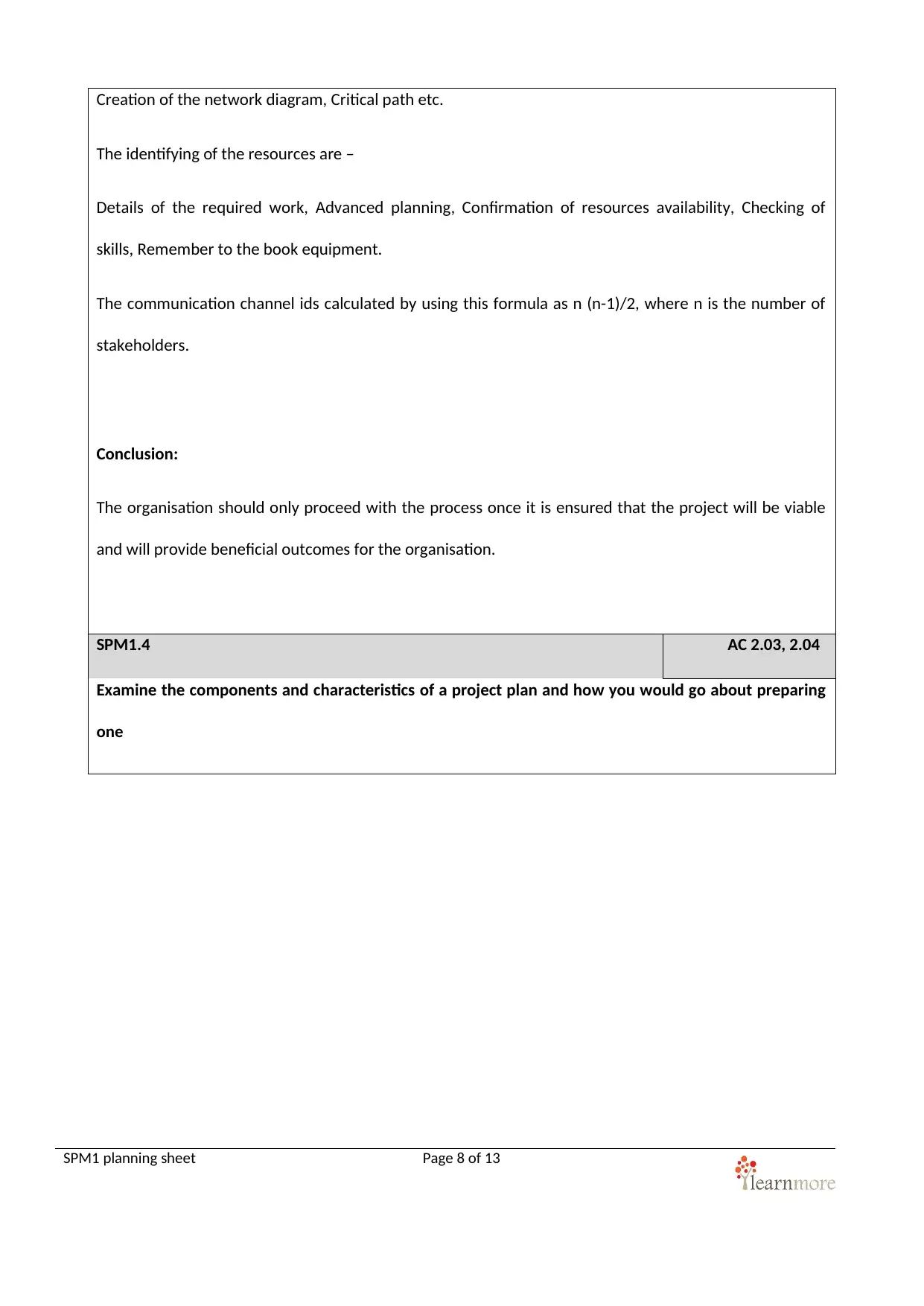
Creation of the network diagram, Critical path etc.
The identifying of the resources are –
Details of the required work, Advanced planning, Confirmation of resources availability, Checking of
skills, Remember to the book equipment.
The communication channel ids calculated by using this formula as n (n-1)/2, where n is the number of
stakeholders.
Conclusion:
The organisation should only proceed with the process once it is ensured that the project will be viable
and will provide beneficial outcomes for the organisation.
SPM1.4 AC 2.03, 2.04
Examine the components and characteristics of a project plan and how you would go about preparing
one
SPM1 planning sheet Page 8 of 13
The identifying of the resources are –
Details of the required work, Advanced planning, Confirmation of resources availability, Checking of
skills, Remember to the book equipment.
The communication channel ids calculated by using this formula as n (n-1)/2, where n is the number of
stakeholders.
Conclusion:
The organisation should only proceed with the process once it is ensured that the project will be viable
and will provide beneficial outcomes for the organisation.
SPM1.4 AC 2.03, 2.04
Examine the components and characteristics of a project plan and how you would go about preparing
one
SPM1 planning sheet Page 8 of 13
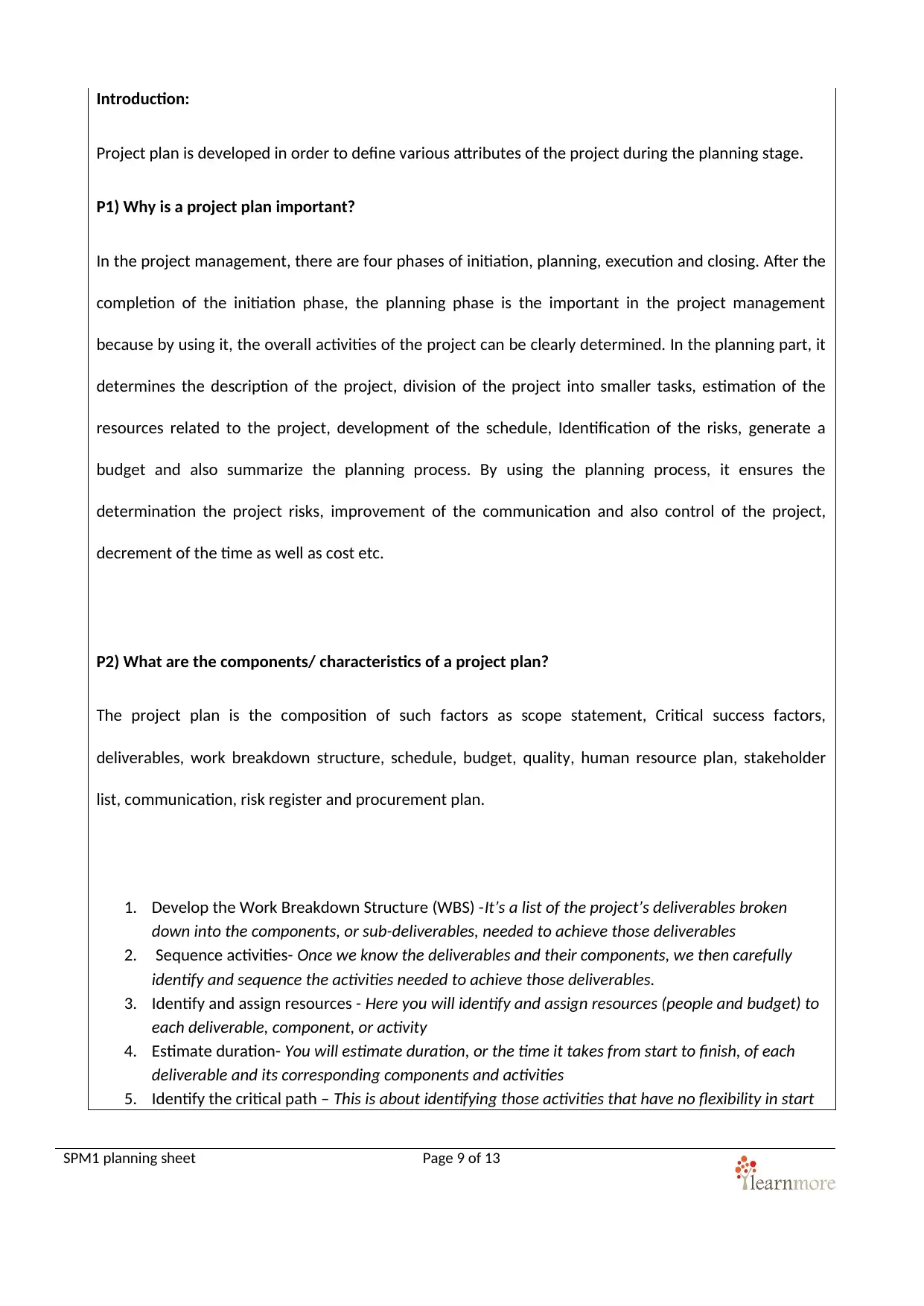
Introduction:
Project plan is developed in order to define various attributes of the project during the planning stage.
P1) Why is a project plan important?
In the project management, there are four phases of initiation, planning, execution and closing. After the
completion of the initiation phase, the planning phase is the important in the project management
because by using it, the overall activities of the project can be clearly determined. In the planning part, it
determines the description of the project, division of the project into smaller tasks, estimation of the
resources related to the project, development of the schedule, Identification of the risks, generate a
budget and also summarize the planning process. By using the planning process, it ensures the
determination the project risks, improvement of the communication and also control of the project,
decrement of the time as well as cost etc.
P2) What are the components/ characteristics of a project plan?
The project plan is the composition of such factors as scope statement, Critical success factors,
deliverables, work breakdown structure, schedule, budget, quality, human resource plan, stakeholder
list, communication, risk register and procurement plan.
1. Develop the Work Breakdown Structure (WBS) -It’s a list of the project’s deliverables broken
down into the components, or sub-deliverables, needed to achieve those deliverables
2. Sequence activities- Once we know the deliverables and their components, we then carefully
identify and sequence the activities needed to achieve those deliverables.
3. Identify and assign resources - Here you will identify and assign resources (people and budget) to
each deliverable, component, or activity
4. Estimate duration- You will estimate duration, or the time it takes from start to finish, of each
deliverable and its corresponding components and activities
5. Identify the critical path – This is about identifying those activities that have no flexibility in start
SPM1 planning sheet Page 9 of 13
Project plan is developed in order to define various attributes of the project during the planning stage.
P1) Why is a project plan important?
In the project management, there are four phases of initiation, planning, execution and closing. After the
completion of the initiation phase, the planning phase is the important in the project management
because by using it, the overall activities of the project can be clearly determined. In the planning part, it
determines the description of the project, division of the project into smaller tasks, estimation of the
resources related to the project, development of the schedule, Identification of the risks, generate a
budget and also summarize the planning process. By using the planning process, it ensures the
determination the project risks, improvement of the communication and also control of the project,
decrement of the time as well as cost etc.
P2) What are the components/ characteristics of a project plan?
The project plan is the composition of such factors as scope statement, Critical success factors,
deliverables, work breakdown structure, schedule, budget, quality, human resource plan, stakeholder
list, communication, risk register and procurement plan.
1. Develop the Work Breakdown Structure (WBS) -It’s a list of the project’s deliverables broken
down into the components, or sub-deliverables, needed to achieve those deliverables
2. Sequence activities- Once we know the deliverables and their components, we then carefully
identify and sequence the activities needed to achieve those deliverables.
3. Identify and assign resources - Here you will identify and assign resources (people and budget) to
each deliverable, component, or activity
4. Estimate duration- You will estimate duration, or the time it takes from start to finish, of each
deliverable and its corresponding components and activities
5. Identify the critical path – This is about identifying those activities that have no flexibility in start
SPM1 planning sheet Page 9 of 13
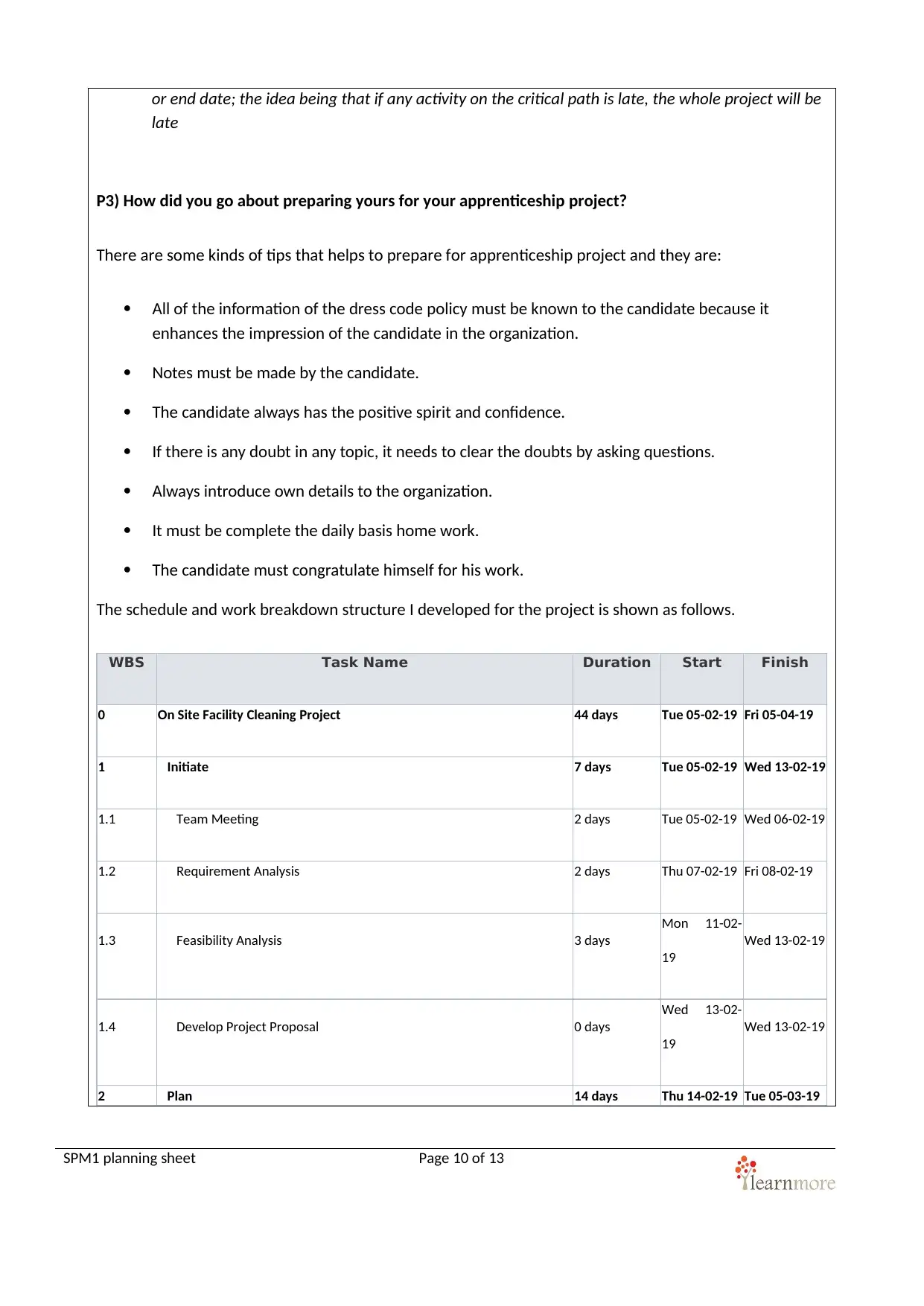
or end date; the idea being that if any activity on the critical path is late, the whole project will be
late
P3) How did you go about preparing yours for your apprenticeship project?
There are some kinds of tips that helps to prepare for apprenticeship project and they are:
All of the information of the dress code policy must be known to the candidate because it
enhances the impression of the candidate in the organization.
Notes must be made by the candidate.
The candidate always has the positive spirit and confidence.
If there is any doubt in any topic, it needs to clear the doubts by asking questions.
Always introduce own details to the organization.
It must be complete the daily basis home work.
The candidate must congratulate himself for his work.
The schedule and work breakdown structure I developed for the project is shown as follows.
WBS Task Name Duration Start Finish
0 On Site Facility Cleaning Project 44 days Tue 05-02-19 Fri 05-04-19
1 Initiate 7 days Tue 05-02-19 Wed 13-02-19
1.1 Team Meeting 2 days Tue 05-02-19 Wed 06-02-19
1.2 Requirement Analysis 2 days Thu 07-02-19 Fri 08-02-19
1.3 Feasibility Analysis 3 days
Mon 11-02-
19
Wed 13-02-19
1.4 Develop Project Proposal 0 days
Wed 13-02-
19
Wed 13-02-19
2 Plan 14 days Thu 14-02-19 Tue 05-03-19
SPM1 planning sheet Page 10 of 13
late
P3) How did you go about preparing yours for your apprenticeship project?
There are some kinds of tips that helps to prepare for apprenticeship project and they are:
All of the information of the dress code policy must be known to the candidate because it
enhances the impression of the candidate in the organization.
Notes must be made by the candidate.
The candidate always has the positive spirit and confidence.
If there is any doubt in any topic, it needs to clear the doubts by asking questions.
Always introduce own details to the organization.
It must be complete the daily basis home work.
The candidate must congratulate himself for his work.
The schedule and work breakdown structure I developed for the project is shown as follows.
WBS Task Name Duration Start Finish
0 On Site Facility Cleaning Project 44 days Tue 05-02-19 Fri 05-04-19
1 Initiate 7 days Tue 05-02-19 Wed 13-02-19
1.1 Team Meeting 2 days Tue 05-02-19 Wed 06-02-19
1.2 Requirement Analysis 2 days Thu 07-02-19 Fri 08-02-19
1.3 Feasibility Analysis 3 days
Mon 11-02-
19
Wed 13-02-19
1.4 Develop Project Proposal 0 days
Wed 13-02-
19
Wed 13-02-19
2 Plan 14 days Thu 14-02-19 Tue 05-03-19
SPM1 planning sheet Page 10 of 13
Secure Best Marks with AI Grader
Need help grading? Try our AI Grader for instant feedback on your assignments.
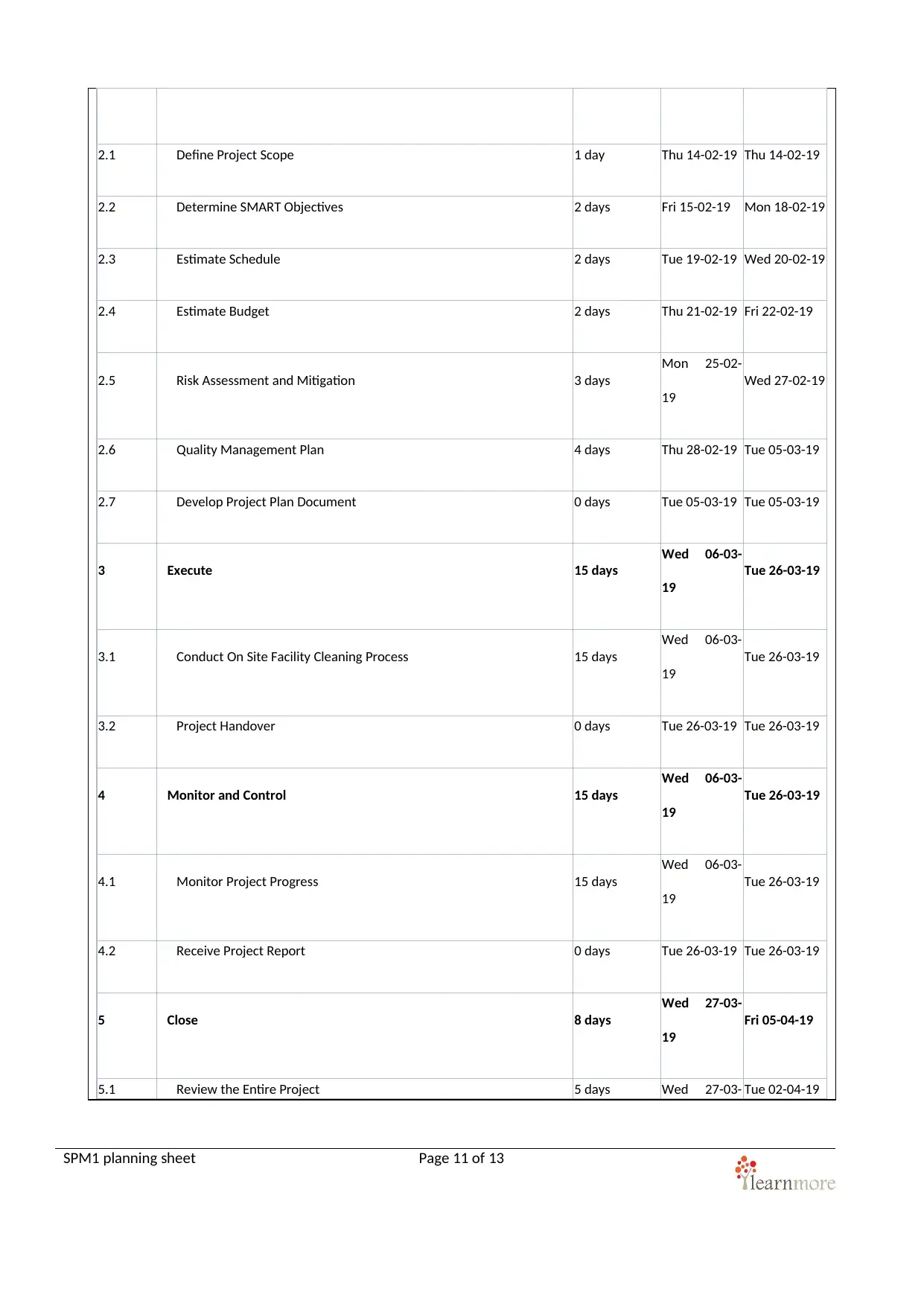
2.1 Define Project Scope 1 day Thu 14-02-19 Thu 14-02-19
2.2 Determine SMART Objectives 2 days Fri 15-02-19 Mon 18-02-19
2.3 Estimate Schedule 2 days Tue 19-02-19 Wed 20-02-19
2.4 Estimate Budget 2 days Thu 21-02-19 Fri 22-02-19
2.5 Risk Assessment and Mitigation 3 days
Mon 25-02-
19
Wed 27-02-19
2.6 Quality Management Plan 4 days Thu 28-02-19 Tue 05-03-19
2.7 Develop Project Plan Document 0 days Tue 05-03-19 Tue 05-03-19
3 Execute 15 days
Wed 06-03-
19
Tue 26-03-19
3.1 Conduct On Site Facility Cleaning Process 15 days
Wed 06-03-
19
Tue 26-03-19
3.2 Project Handover 0 days Tue 26-03-19 Tue 26-03-19
4 Monitor and Control 15 days
Wed 06-03-
19
Tue 26-03-19
4.1 Monitor Project Progress 15 days
Wed 06-03-
19
Tue 26-03-19
4.2 Receive Project Report 0 days Tue 26-03-19 Tue 26-03-19
5 Close 8 days
Wed 27-03-
19
Fri 05-04-19
5.1 Review the Entire Project 5 days Wed 27-03- Tue 02-04-19
SPM1 planning sheet Page 11 of 13
2.2 Determine SMART Objectives 2 days Fri 15-02-19 Mon 18-02-19
2.3 Estimate Schedule 2 days Tue 19-02-19 Wed 20-02-19
2.4 Estimate Budget 2 days Thu 21-02-19 Fri 22-02-19
2.5 Risk Assessment and Mitigation 3 days
Mon 25-02-
19
Wed 27-02-19
2.6 Quality Management Plan 4 days Thu 28-02-19 Tue 05-03-19
2.7 Develop Project Plan Document 0 days Tue 05-03-19 Tue 05-03-19
3 Execute 15 days
Wed 06-03-
19
Tue 26-03-19
3.1 Conduct On Site Facility Cleaning Process 15 days
Wed 06-03-
19
Tue 26-03-19
3.2 Project Handover 0 days Tue 26-03-19 Tue 26-03-19
4 Monitor and Control 15 days
Wed 06-03-
19
Tue 26-03-19
4.1 Monitor Project Progress 15 days
Wed 06-03-
19
Tue 26-03-19
4.2 Receive Project Report 0 days Tue 26-03-19 Tue 26-03-19
5 Close 8 days
Wed 27-03-
19
Fri 05-04-19
5.1 Review the Entire Project 5 days Wed 27-03- Tue 02-04-19
SPM1 planning sheet Page 11 of 13
1 out of 11
Related Documents
Your All-in-One AI-Powered Toolkit for Academic Success.
+13062052269
info@desklib.com
Available 24*7 on WhatsApp / Email
![[object Object]](/_next/static/media/star-bottom.7253800d.svg)
Unlock your academic potential
© 2024 | Zucol Services PVT LTD | All rights reserved.




